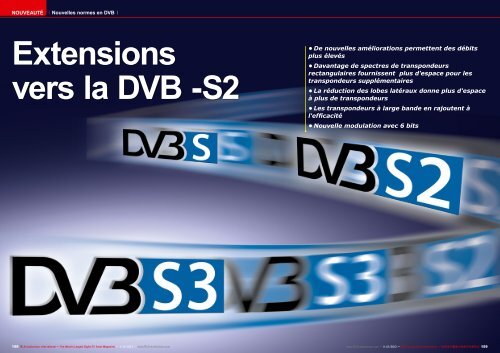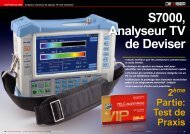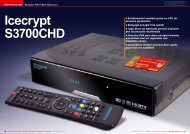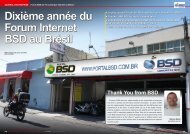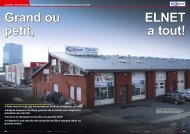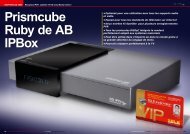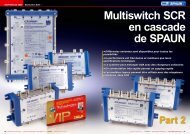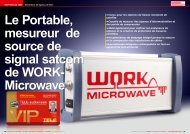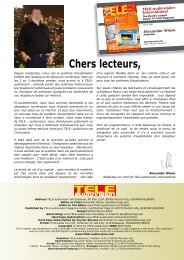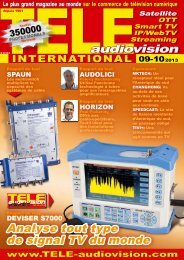Extensions vers la DVB -S2
Create successful ePaper yourself
Turn your PDF publications into a flip-book with our unique Google optimized e-Paper software.
Nouveauté<br />
Nouvelles normes en <strong>DVB</strong><br />
<strong>Extensions</strong><br />
<strong>vers</strong> <strong>la</strong> <strong>DVB</strong> -<strong>S2</strong><br />
• De nouvelles améliorations permettent des débits<br />
plus élevés<br />
• Davantage de spectres de transpondeurs<br />
rectangu<strong>la</strong>ires fournissent plus d'espace pour les<br />
transpondeurs supplémentaires<br />
• La réduction des lobes <strong>la</strong>téraux donne plus d'espace<br />
à plus de transpondeurs<br />
• Les transpondeurs à <strong>la</strong>rge bande en rajoutent à<br />
l'efficacité<br />
• Nouvelle modu<strong>la</strong>tion avec 6 bits<br />
158 TELE-audiovision International — The World‘s Largest Digital TV Trade Magazine — 11-12/2013 — www.TELE-audiovision.com<br />
www.TELE-audiovision.com — 11-12/2013 — TELE-audiovision International — 全 球 发 行 量 最 大 的 数 字 电 视 杂 志 159
FEATURE<br />
New <strong>DVB</strong> Standards<br />
What‘s coming next<br />
after <strong>DVB</strong>-<strong>S2</strong>?<br />
Jacek Pawlowski<br />
The <strong>DVB</strong>-<strong>S2</strong> standard was first published<br />
in 2005. While the performance<br />
it offers may still impress us nowadays,<br />
the advances in technology and growing<br />
demand for higher and higher data<br />
rates make the satellite industry search<br />
for even more efficient ways to transfer<br />
huge amount of data most notably the<br />
high demands generated by Ultra High<br />
Definition TV (UHDTV) and high speed<br />
IP services over satellite.<br />
Recently in TELE-audiovision 07-<br />
08/2013 we have published a feature<br />
articles about the new UHDTV standard<br />
and the video compression standard<br />
HEVC, also known as H.265 – a successor<br />
of MPEG-4 (H.264). These new<br />
solutions require new hardware and<br />
software. It makes a good moment to<br />
improve also the modu<strong>la</strong>tion, coding<br />
and error correction standard as defined<br />
by the <strong>DVB</strong>-<strong>S2</strong> standard.<br />
As the proposed improvements have<br />
not yet been blessed by the <strong>DVB</strong> organization<br />
we will call them the proposed<br />
extensions to <strong>DVB</strong>-<strong>S2</strong>. However,<br />
real hardware devices have been built<br />
and various test have been performed<br />
to prove these new concepts. These<br />
new <strong>DVB</strong>-<strong>S2</strong> extensions are <strong>la</strong>belled as<br />
<strong>DVB</strong>-<strong>S2</strong>EB1, <strong>DVB</strong>-Sx or even <strong>DVB</strong>-S3<br />
although such a standard does not yet<br />
officially exist in this moment.<br />
The proposed extensions can give a<br />
20% increase in data rate compared<br />
to <strong>DVB</strong>-<strong>S2</strong> in DTH (Direct-To-Home)<br />
broadcasts. For professional services,<br />
like VSAT communication, the gain can<br />
be as high as 64%.<br />
So, what exactly are these extensions?<br />
Here is our list:<br />
- reduction of the roll-off factors and<br />
the side lobes of digitally modu<strong>la</strong>ted<br />
carriers<br />
- use of wide bandwidth transponders<br />
- additional modu<strong>la</strong>tion: 64 APSK<br />
- more modu<strong>la</strong>tion and coding (MOD-<br />
COM) schemes and forward error correction<br />
(FEC) choices and non-linear<br />
MODCOMs<br />
Not all of the extensions are easy to<br />
■<br />
Figure 1. With smaller roll-offs, transponders can be squeezed closer to one another.<br />
comprehend but in this features article<br />
we try to help you to get a general idea<br />
on most of them.<br />
The roll-off factor describes the<br />
shape of the transponder spectrum as<br />
seen on a spectrum analyzer. Its value<br />
tells you how close to an ideal rectangu<strong>la</strong>r<br />
the spectrum is. The smaller it<br />
is the more steep are the slopes of a<br />
transponder spectrum. <strong>DVB</strong>-S requires<br />
a roll-off of 35%, <strong>DVB</strong>-<strong>S2</strong> of 20% and<br />
25% while the the proposed <strong>S2</strong> extensions<br />
aim at 15%, 10% and 5%. It is<br />
easy to understand that with smaller<br />
roll-offs one can position transponders<br />
closer to one another in the frequency<br />
domain and gain a free space for additional<br />
ones in the same Ku-Band or<br />
C-Band.<br />
However, not only (re<strong>la</strong>tively) big rolloffs<br />
prevent closer location of the <strong>DVB</strong>-<br />
<strong>S2</strong> transponders. So called side lobes<br />
are normally present on both sides of<br />
the useful signal. These are unwanted<br />
artifacts after modu<strong>la</strong>tion. With today’s<br />
technology it is possible to practically<br />
get rid of them thanks to improved<br />
filtering. Once they are removed, the<br />
center frequencies of the neighboring<br />
transponders can be set closer to one<br />
another.<br />
If you take a look at Figure 2, you can<br />
come to the conclusion that even after<br />
removing side lobes and improving<br />
roll-offs, there is still some spectrum<br />
wasted between the transponders. And<br />
that’s why wideband transponders are<br />
the next trick in improving efficiency.<br />
Their throughput is increased to 72 Ms/<br />
sec. When compared with the most<br />
popu<strong>la</strong>r 27.5 Ms/sec transponders, the<br />
wideband ones are three times wider in<br />
spectral view.<br />
Every new <strong>DVB</strong> standard introduces a<br />
new modu<strong>la</strong>tion schemes. <strong>DVB</strong>-<strong>S2</strong> ended<br />
up with 32 APSK. The proposed extensions<br />
call for 64 APSK. In this modu<strong>la</strong>tion,<br />
every symbol is made up of 6<br />
bits. Of course, the higher the order of<br />
modu<strong>la</strong>tion, the smaller the differences<br />
in amplitude and phase between simi<strong>la</strong>r<br />
symbols. We can send more data in the<br />
■Figure 2. Reducing side lobes by more efficient filtering contributes to better bandwidth utilization.<br />
same bandwidth but the signal is more<br />
sensitive to interference and noise. 64<br />
APSK will be used in professional setups<br />
with <strong>la</strong>rge antennas rather than in<br />
DTH transmissions.<br />
Probably the same goes true for the<br />
<strong>la</strong>st extension mentioned in the beginning<br />
of this article: more MODCOM and<br />
FEC values. These parameters generally<br />
describe how big overhead is introduced<br />
in the data stream to the useful<br />
payload. The overhead in bit rate is<br />
needed for error correction. Once we<br />
have more possibilities here, we can<br />
almost smoothly change the proportion<br />
between useful and corrective bits<br />
in order to find a minimum overhead<br />
still ensuring faultless processing. Such<br />
Wideband transponder<br />
thing is possible when we have a pointto-point<br />
two-way communication. In<br />
case of a reception problem, the system<br />
automatically adjusts MODCOM/<br />
FEC.<br />
Also the wideband transponders<br />
described above require the reception<br />
system to be of a higher performance<br />
because the carrier-to-noise<br />
ratio degrades proportionally with the<br />
bandwidth increase. The best way to<br />
maintain a good C/R is to use a bigger<br />
dish. Therefore, it is not certain if wideband<br />
transponders will be used for DTH<br />
broadcasts. After all, not too many end<br />
users will be eager to rep<strong>la</strong>ce their 60-<br />
90 cm dishes with <strong>la</strong>rger ones.<br />
That’s why the experts assume that in<br />
■Figure 3. Wideband transponders use frequency spectrum more efficiently.<br />
DTH transmissions only about 20% increase<br />
in the efficiency is realistic while<br />
in professional links even 64% would be<br />
possible. Anyway, we can not say today<br />
which particu<strong>la</strong>r extension proposals<br />
will be included in the eventual settlement<br />
of the <strong>DVB</strong>-S3 standard. Maybe<br />
only some of the above, maybe all of<br />
them. We will not be surprised though<br />
if brand new concepts are worked out<br />
in meantime and included in the new<br />
standard.<br />
One thing is for sure: the improvements<br />
will enable higher useful data<br />
rates in the existing satellite communication<br />
channels and this will be an<br />
important factor enabling UHDTV and<br />
other wideband services.<br />
160 TELE-audiovision International — The World‘s Largest Digital TV Trade Magazine — 11-12/2013 — www.TELE-audiovision.com<br />
www.TELE-audiovision.com — 11-12/2013 — TELE-audiovision International — 全 球 发 行 量 最 大 的 数 字 电 视 杂 志 161


